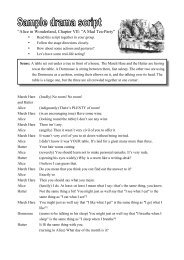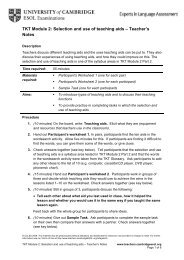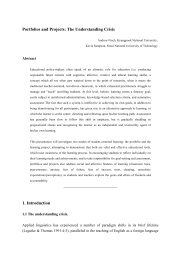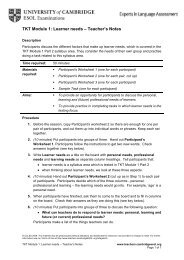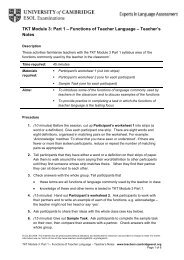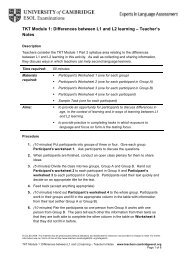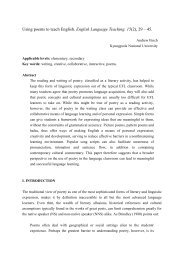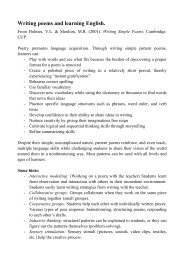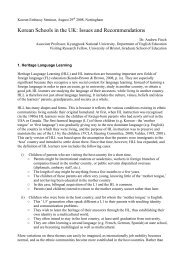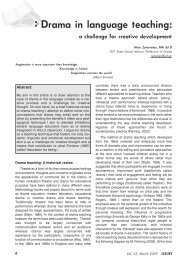focus on form instruction: foundations, applications, and ... - Finchpark
focus on form instruction: foundations, applications, and ... - Finchpark
focus on form instruction: foundations, applications, and ... - Finchpark
Create successful ePaper yourself
Turn your PDF publications into a flip-book with our unique Google optimized e-Paper software.
47<br />
The Reading Matrix<br />
Vol. 5, No. 1, April 2005<br />
FOCUS ON FORM INSTRUCTION: FOUNDATIONS, APPLICATIONS, AND<br />
CRITICISMS<br />
Alex Poole<br />
Email: alex.poole@wku.edu<br />
Abstract<br />
_________________<br />
Focus <strong>on</strong> <strong>form</strong> instructi<strong>on</strong> makes up an important part of the literature <strong>on</strong> sec<strong>on</strong>d language<br />
acquisiti<strong>on</strong> research. However, few works have both summarized <strong>and</strong> critically evaluated <str<strong>on</strong>g>focus</str<strong>on</strong>g><br />
<strong>on</strong> <strong>form</strong> instructi<strong>on</strong>. This article seeks to fill this gap. More precisely, it reviews its main<br />
principles, <strong>and</strong> points out the difficulties of implementing this relatively new pedagogical<br />
innovati<strong>on</strong> in all but a limited number of instructi<strong>on</strong>al settings. It c<strong>on</strong>cludes by proposing<br />
c<strong>on</strong>diti<strong>on</strong>s under which <str<strong>on</strong>g>focus</str<strong>on</strong>g> <strong>on</strong> <strong>form</strong> instructi<strong>on</strong> could effectively functi<strong>on</strong>.<br />
__________________<br />
Introducti<strong>on</strong><br />
By glancing at the table of c<strong>on</strong>tents in major English language teaching journals, <strong>on</strong>e will<br />
quickly realize that <str<strong>on</strong>g>focus</str<strong>on</strong>g> <strong>on</strong> <strong>form</strong> instructi<strong>on</strong> is a key theme in many empirical <strong>and</strong> descriptive<br />
research articles. Clearly, this innovati<strong>on</strong>, which was put forth by L<strong>on</strong>g (1991) <strong>and</strong> L<strong>on</strong>g <strong>and</strong><br />
Robins<strong>on</strong> (1998), has been a source of great enthusiasm for English language teachers <strong>and</strong><br />
researchers, so much so that many have praised it as if it were the miracle method they had<br />
always been searching for. However, this enthusiasm needs to be curbed, since studies of <str<strong>on</strong>g>focus</str<strong>on</strong>g><br />
<strong>on</strong> <strong>form</strong> instructi<strong>on</strong> present a mixed picture of its ability to promote L2 grammatical acquisiti<strong>on</strong>.<br />
In additi<strong>on</strong>, the empirical, curricular, practical, linguistic, <strong>and</strong> cultural realities of many English<br />
language teaching settings make it unlikely that <str<strong>on</strong>g>focus</str<strong>on</strong>g> <strong>on</strong> <strong>form</strong> will become widely adopted.<br />
In this critical analysis, my purpose is threefold: (1) to highlight the central aspects of<br />
<str<strong>on</strong>g>focus</str<strong>on</strong>g> <strong>on</strong> <strong>form</strong> instructi<strong>on</strong>; (2) to review some of the major research studies examining <str<strong>on</strong>g>focus</str<strong>on</strong>g> <strong>on</strong><br />
<strong>form</strong> instructi<strong>on</strong>; (3) <strong>and</strong> to show the barriers of implementing <str<strong>on</strong>g>focus</str<strong>on</strong>g> <strong>on</strong> <strong>form</strong> instructi<strong>on</strong> in many<br />
English language teaching c<strong>on</strong>texts. However, my point is not to actively discourage teachers<br />
<strong>and</strong> curricula designers from incorporating <str<strong>on</strong>g>focus</str<strong>on</strong>g> <strong>on</strong> <strong>form</strong> instructi<strong>on</strong> into their instructi<strong>on</strong>al<br />
schema. Instead, my intenti<strong>on</strong> is to help teachers <strong>and</strong> curricula designers decipher whether or not<br />
<str<strong>on</strong>g>focus</str<strong>on</strong>g> <strong>on</strong> <strong>form</strong> instructi<strong>on</strong> is appropriate for their pedagogical realities, <strong>and</strong> furthermore, to help<br />
teacher trainers put <str<strong>on</strong>g>focus</str<strong>on</strong>g> <strong>on</strong> <strong>form</strong> instructi<strong>on</strong> into a critical perspective when presenting it future<br />
teachers, so that they, in turn, might make in<strong>form</strong>ed curricular <strong>and</strong> classroom choices regarding<br />
its use.<br />
Review of Literature<br />
Focus <strong>on</strong> Form Instructi<strong>on</strong>: Foundati<strong>on</strong>s <strong>and</strong> Applicati<strong>on</strong>s<br />
In short, <str<strong>on</strong>g>focus</str<strong>on</strong>g> <strong>on</strong> <strong>form</strong> instructi<strong>on</strong> is a type of instructi<strong>on</strong> that, <strong>on</strong> the <strong>on</strong>e h<strong>and</strong>, holds up<br />
the importance of communicative language teaching principles such as authentic communicati<strong>on</strong><br />
<strong>and</strong> student-centeredness, <strong>and</strong>, <strong>on</strong> the other h<strong>and</strong>, maintains the value of the occasi<strong>on</strong>al <strong>and</strong> overt<br />
study of problematic L2 grammatical <strong>form</strong>s, which is more reminiscent of n<strong>on</strong>communicative
teaching (L<strong>on</strong>g, 1991). Furthermore, L<strong>on</strong>g <strong>and</strong> Robins<strong>on</strong> (1998) argue that the resp<strong>on</strong>sibility of<br />
helping learners attend to <strong>and</strong> underst<strong>and</strong> problematic L2 grammatical <strong>form</strong>s falls not <strong>on</strong>ly <strong>on</strong><br />
their teachers, but also <strong>on</strong> their peers. In other words, L<strong>on</strong>g (1991) <strong>and</strong> L<strong>on</strong>g <strong>and</strong> Robins<strong>on</strong><br />
(1998) claim that <strong>form</strong>al L2 instructi<strong>on</strong> should give most of its attenti<strong>on</strong> to exposing students to<br />
oral <strong>and</strong> written discourse that mirrors real-life, such as doing job interviews, writing letter to<br />
friends, <strong>and</strong> engaging in classroom debates; n<strong>on</strong>etheless, when it is observed that learners are<br />
experiencing difficulties in the comprehensi<strong>on</strong> <strong>and</strong>/or producti<strong>on</strong> of certain L2 grammatical<br />
<strong>form</strong>s, teachers <strong>and</strong> their peers are obligated to assist them notice their err<strong>on</strong>eous use <strong>and</strong>/or<br />
comprehensi<strong>on</strong> of these <strong>form</strong>s <strong>and</strong> supply them with the proper explanati<strong>on</strong>s <strong>and</strong> models of<br />
them. Moreover, teachers can help their students <strong>and</strong> learners can help their peers notice the<br />
<strong>form</strong>s that they currently lack, yet should know in order to further their overall L2 grammatical<br />
development.<br />
Thus, L<strong>on</strong>g <strong>and</strong> Robins<strong>on</strong> (1998) assert that teachers <strong>and</strong> curricula designers are not to<br />
<str<strong>on</strong>g>focus</str<strong>on</strong>g> instructi<strong>on</strong> <strong>on</strong> the teaching/learning of specific L2 grammatical items. Instead, they should<br />
aim to help students learn how to use language in a way that emulates realistic communicative<br />
scenarios. More to the point, teacher-student/student-student classroom interacti<strong>on</strong>, via both oral<br />
<strong>and</strong> written modes, should c<strong>on</strong>sume the majority of class time. Likewise, evaluati<strong>on</strong> should<br />
center <strong>on</strong> students’ abilities to actively engage in authentic communicati<strong>on</strong>, using the <strong>form</strong>s they<br />
have learned during interacti<strong>on</strong>.<br />
For L<strong>on</strong>g (1991) <strong>and</strong> L<strong>on</strong>g <strong>and</strong> Robins<strong>on</strong> (1998), <str<strong>on</strong>g>focus</str<strong>on</strong>g> <strong>on</strong> <strong>form</strong> instructi<strong>on</strong> is different<br />
from modes of instructi<strong>on</strong> that, in general, are aimed at teaching specific L2 grammatical <strong>form</strong>s,<br />
rather than presenting language as an mechanism for communicati<strong>on</strong>. This type of instructi<strong>on</strong>,<br />
which L<strong>on</strong>g <strong>and</strong> Robins<strong>on</strong> call <str<strong>on</strong>g>focus</str<strong>on</strong>g> <strong>on</strong> <strong>form</strong>s instructi<strong>on</strong>, has been featured in the syllabi of<br />
methods such as the Situati<strong>on</strong>al Language Teaching <strong>and</strong> the Audiolingual Method. In these<br />
methods, instructi<strong>on</strong> progresses as learners exhibit mastery of the sequentially- presented<br />
grammatical structures, <strong>and</strong> thus are generally n<strong>on</strong>-communicative in the sense that they do not<br />
foster L2 development that enables learners to engage in real-life communicati<strong>on</strong>. In additi<strong>on</strong>,<br />
such methods <str<strong>on</strong>g>focus</str<strong>on</strong>g> <strong>on</strong> the prescribed L2 grammatical <strong>form</strong>s that the teacher can transmit to<br />
his/her students; in this way, they are teacher-centered. Focus <strong>on</strong> <strong>form</strong> instructi<strong>on</strong>, in c<strong>on</strong>trast, is<br />
learner-centered due to its aim of resp<strong>on</strong>ding to learners’ perceived needs in a sp<strong>on</strong>taneous<br />
manner.<br />
L<strong>on</strong>g (1991) <strong>and</strong> L<strong>on</strong>g <strong>and</strong> Robins<strong>on</strong> (1998) also argue that <str<strong>on</strong>g>focus</str<strong>on</strong>g> <strong>on</strong> <strong>form</strong> instructi<strong>on</strong> is<br />
different from the purely communicative instructi<strong>on</strong>, or what they call <str<strong>on</strong>g>focus</str<strong>on</strong>g> <strong>on</strong> meaning<br />
instructi<strong>on</strong>. For them, <str<strong>on</strong>g>focus</str<strong>on</strong>g> <strong>on</strong> meaning instructi<strong>on</strong> is paramount to spending little or no time <strong>on</strong><br />
the discrete parts of language; instead, the interest is <strong>on</strong> the use of language in real-life situati<strong>on</strong>s.<br />
Such a mode of instructi<strong>on</strong> is apparent in the Natural Approach (Terrell <strong>and</strong> Krashen, 1983),<br />
which, in theory, prohibits direct grammar teaching. In c<strong>on</strong>trast, L<strong>on</strong>g (1991) <strong>and</strong> L<strong>on</strong>g <strong>and</strong><br />
Robins<strong>on</strong> (1998) assert that the occasi<strong>on</strong>al <str<strong>on</strong>g>focus</str<strong>on</strong>g> <strong>on</strong> the discrete-<strong>form</strong>s of the L2 via correcti<strong>on</strong>,<br />
negative feedback, direct explanati<strong>on</strong>s, recasts, etc., can help students become aware of,<br />
underst<strong>and</strong>, <strong>and</strong> ultimately acquire difficult <strong>form</strong>s.<br />
In sum, both <str<strong>on</strong>g>focus</str<strong>on</strong>g> <strong>on</strong> <strong>form</strong>s <strong>and</strong> <str<strong>on</strong>g>focus</str<strong>on</strong>g> <strong>on</strong> meaning instructi<strong>on</strong> are valuable, according to<br />
L<strong>on</strong>g (1991) <strong>and</strong> L<strong>on</strong>g <strong>and</strong> Robins<strong>on</strong> (1998), <strong>and</strong> should complement rather than exclude each<br />
other. Focus <strong>on</strong> <strong>form</strong> instructi<strong>on</strong>, in their view, maintains a balance between the two by calling<br />
<strong>on</strong> teachers <strong>and</strong> learners to attend to <strong>form</strong> when necessary, yet within a communicative<br />
classroom envir<strong>on</strong>ment. However, L<strong>on</strong>g (1991) <strong>and</strong> L<strong>on</strong>g <strong>and</strong> Robins<strong>on</strong> (1998) do not guarantee<br />
that <str<strong>on</strong>g>focus</str<strong>on</strong>g> <strong>on</strong> <strong>form</strong> instructi<strong>on</strong> will lead to a specific level of L2 grammatical development within<br />
48
49<br />
a certain time frame, presumably because of factors related to quality of instructi<strong>on</strong>, intensity of<br />
instructi<strong>on</strong>, <strong>and</strong> the stages of morphosyntactic development through which L2 learners must pass<br />
(Lightbown <strong>and</strong> Spada, 1999).<br />
Focus <strong>on</strong> Form Instructi<strong>on</strong>: Selected Studies<br />
A look at recent research in the area of sec<strong>on</strong>d language acquisiti<strong>on</strong> reveals that <str<strong>on</strong>g>focus</str<strong>on</strong>g> <strong>on</strong><br />
<strong>form</strong> instructi<strong>on</strong> has been empirically evaluated using a variety of methodologies. Leeman,<br />
Arteagoitia, Fridman, <strong>and</strong> Doughty (1995), for example, compared <str<strong>on</strong>g>focus</str<strong>on</strong>g> <strong>on</strong> <strong>form</strong> instructi<strong>on</strong> <strong>and</strong><br />
<str<strong>on</strong>g>focus</str<strong>on</strong>g> <strong>on</strong> meaning instructi<strong>on</strong>. The participants c<strong>on</strong>sisted of two groups of US college students in<br />
advanced Spanish classes, <strong>on</strong>e of which received <str<strong>on</strong>g>focus</str<strong>on</strong>g> <strong>on</strong> <strong>form</strong> instructi<strong>on</strong>, the other of which<br />
received <str<strong>on</strong>g>focus</str<strong>on</strong>g> <strong>on</strong> meaning instructi<strong>on</strong>. Post-tests revealed that those students who received <str<strong>on</strong>g>focus</str<strong>on</strong>g><br />
<strong>on</strong> <strong>form</strong> instructi<strong>on</strong> were more accurate in their producti<strong>on</strong> of Spanish verbs than were those who<br />
received <str<strong>on</strong>g>focus</str<strong>on</strong>g> <strong>on</strong> meaning instructi<strong>on</strong>. Doughty <strong>and</strong> Verela (1998) examined the differences in<br />
the acquisiti<strong>on</strong> of English tense between junior high US ESL science students who received<br />
corrective recasts <strong>and</strong> those who received teacher-led instructi<strong>on</strong>, mostly in the <strong>form</strong> of lectures.<br />
Regardless of the type of instructi<strong>on</strong> they were exposed to, learners took pre-tests <strong>and</strong> post-tests.<br />
Those students who received corrective recasts per<strong>form</strong>ed significantly better <strong>on</strong> post-tests than<br />
did those who received teacher-led instructi<strong>on</strong>. Jourdenais, Ota, Stauffer, Boys<strong>on</strong>, <strong>and</strong> Doughty<br />
(1995) studied the c<strong>on</strong>cept of textual enhancement, which involves highlighting <strong>form</strong>s with the<br />
idea that students will attend to them more frequently. In <strong>on</strong>e sec<strong>on</strong>d- semester college Spanish<br />
class, they established two groups, <strong>on</strong>e of which was exposed to Spanish verbs using enhanced<br />
texts, <strong>and</strong> a c<strong>on</strong>trol group, which did not receive enhanced texts. Think-aloud protocols revealed<br />
that those in the experimental group attended to Spanish verb <strong>form</strong>s more frequently than the<br />
c<strong>on</strong>trol groups. Williams <strong>and</strong> Evans (1998) studied the precisi<strong>on</strong> with which intermediate-level<br />
ESL learners used the passive voice <strong>and</strong> adjectival participles. Two groups were established, <strong>on</strong>e<br />
which received input flooding, <strong>and</strong> <strong>on</strong>e which acted as a c<strong>on</strong>trol group. The results dem<strong>on</strong>strated<br />
that the experimental group showed more accurate use of the passive than did the c<strong>on</strong>trol group,<br />
yet no significant differences were seen between the groups in terms of their use of adjectival<br />
participles. Van Patten <strong>and</strong> Oikken<strong>on</strong> (1996) investigated the effects of processing instructi<strong>on</strong> <strong>on</strong><br />
a group of sec<strong>on</strong>dary students studying Spanish at the intermediate level. Processing instructi<strong>on</strong><br />
involves an explicit explanati<strong>on</strong> of a certain grammatical rule, followed by c<strong>on</strong>textualized<br />
practice activities. Participants were divided into three groups, <strong>on</strong>e which received explicit<br />
explanati<strong>on</strong>s of rules, <strong>on</strong>e which received c<strong>on</strong>textualized practice activities, <strong>and</strong> <strong>on</strong>e which<br />
received both explicit explanati<strong>on</strong>s of rules <strong>and</strong> c<strong>on</strong>textualized practice activities. They found<br />
that those who <strong>on</strong>ly received explicit explanati<strong>on</strong>s retained the fewest grammatical rules; the<br />
other two groups, <strong>on</strong> the other h<strong>and</strong>, achieved significantly higher scores <strong>on</strong> post-treatment tests.<br />
Roberts (1995) analyzed the effectiveness of error correcti<strong>on</strong> in beginning-level students of<br />
Japanese at the University of Hawaii. While his study was largely descriptive <strong>and</strong> c<strong>on</strong>tained<br />
small numbers of participants, it showed that <str<strong>on</strong>g>focus</str<strong>on</strong>g>ing <strong>on</strong> learners’ written grammatical errors<br />
was more successful when errors were c<strong>on</strong>textualized <strong>and</strong> understood by learners.<br />
Perhaps the most interesting studies of <str<strong>on</strong>g>focus</str<strong>on</strong>g> <strong>on</strong> <strong>form</strong> instructi<strong>on</strong> are those that have<br />
sought to describe what happens in its student-generated variety, particularly those by Williams<br />
(1999) <strong>and</strong> Poole (2003a). In the case of the <strong>form</strong>er, eight students of various proficiency levels<br />
studying in an intensive English institute in the United States were tape-recorded daily during<br />
45-minute class period for eight weeks. During this time, they were involved in group activities.<br />
Williams sought out to describe the types of <strong>form</strong>s that they attended to. Overall, the results
50<br />
revealed that, am<strong>on</strong>g other things, students infrequently attended to grammar (20%) in favor of<br />
vocabulary (80%). In the latter, Poole (2003a) replicated Williams’ (1999) study using 19 ESL<br />
students in an advanced writing class in a large US university. Students were tape-recorded for<br />
10 weeks for a total of nine hours, during which time they were engaged in a variety of<br />
communicative group activities. As in Williams’ (1999) study, the majority of students attended<br />
to vocabulary (89.8%) instead of grammar (10.2%). Although more research needs to be d<strong>on</strong>e <strong>on</strong><br />
student-generated <str<strong>on</strong>g>focus</str<strong>on</strong>g> <strong>on</strong> <strong>form</strong> instructi<strong>on</strong> in order to find out more about how learners<br />
themselves attend to <strong>form</strong>, the results from these studies suggest that learners are not able <strong>and</strong>/or<br />
willing to attend to L2 grammatical <strong>form</strong>s, thus calling into questi<strong>on</strong> the efficacy of <str<strong>on</strong>g>focus</str<strong>on</strong>g> <strong>on</strong><br />
<strong>form</strong> instructi<strong>on</strong> in fostering L2 grammatical development, at least in its student-generated<br />
variety.<br />
Criticisms of Focus <strong>on</strong> Form Instructi<strong>on</strong>: Empirical, Curricular, Practical, Linguistic, <strong>and</strong><br />
Cultural<br />
While these studies <strong>and</strong> others provide insight into the efficacy of <str<strong>on</strong>g>focus</str<strong>on</strong>g> <strong>on</strong> <strong>form</strong><br />
instructi<strong>on</strong> (See Byrnes, 2000 <strong>and</strong> Lee, 2000 for further summaries of <str<strong>on</strong>g>focus</str<strong>on</strong>g> <strong>on</strong> <strong>form</strong>-related<br />
research), they all have taken place in settings that appear to be well-funded, adequately supplied<br />
with teaching <strong>and</strong> learning materials, <strong>and</strong> generally free of classroom discipline problems.<br />
Moreover, most studies of <str<strong>on</strong>g>focus</str<strong>on</strong>g> <strong>on</strong> <strong>form</strong> instructi<strong>on</strong> have taken place in a few countries, notably<br />
the United States, New Zeal<strong>and</strong>, <strong>and</strong> Japan (Poole <strong>and</strong> Sheorey, 2002). In fact, not a single<br />
empirical study can be found that took place in a setting in which classes were overcrowded, upto-date<br />
materials were generally not available, <strong>and</strong> teachers received less than adequate training<br />
in language skills <strong>and</strong> pedagogy. Unfortunately, much public school ESL instructi<strong>on</strong> in the<br />
United States takes place under circumstances in which teachers are not adequately trained,<br />
proper funds are not provided for appropriate pedagogical materials, <strong>and</strong> learners have a number<br />
of educati<strong>on</strong>al needs, bey<strong>on</strong>d language (Klinger <strong>and</strong> Vaughn, 2000; Mora, 2000). In fact,<br />
according to Baker <strong>and</strong> Markham (2002), eight US states provide no special funding for ESL<br />
students, in spite of growing numbers of students nati<strong>on</strong>wide, <strong>and</strong> the c<strong>on</strong>tinuing poor academic<br />
per<strong>form</strong>ance of this group of school-aged children. Likewise, no study supporting <str<strong>on</strong>g>focus</str<strong>on</strong>g> <strong>on</strong> <strong>form</strong><br />
instructi<strong>on</strong> appears to have taken place in a developing country, where the socioec<strong>on</strong>omic,<br />
political, <strong>and</strong> pedagogical realities may differ significantly from those in more developed<br />
countries. Thus, instructors <strong>and</strong> curricula designers in many settings have little in<strong>form</strong>ati<strong>on</strong> <strong>on</strong><br />
which to judge whether or not <str<strong>on</strong>g>focus</str<strong>on</strong>g> <strong>on</strong> <strong>form</strong> instructi<strong>on</strong> would be appropriate in their programs.<br />
However, English as a Foreign Language (EFL) learners <strong>and</strong> Limited English Proficiency (LEP)<br />
students in the United States comprise a large porti<strong>on</strong> of global English learners.<br />
Even though <str<strong>on</strong>g>focus</str<strong>on</strong>g> <strong>on</strong> <strong>form</strong> instructi<strong>on</strong> has yet to be investigated in many settings, it<br />
appears to be currently undoable in many circumstances due to curricular c<strong>on</strong>straints. In<br />
particular, in many sec<strong>on</strong>dary <strong>and</strong> university language programs, teachers are obligated to teach<br />
certain <strong>form</strong>s in a specific order by using government-m<strong>and</strong>ated materials. Sheorey <strong>and</strong> Nayar<br />
(2002), for instance, point out that such “top-down” (Richards <strong>and</strong> Rodgers, 2001) curricula<br />
planning is frequently seen in India: “Teachers have little say in designing the curriculum,<br />
choosing the materials <strong>and</strong> textbooks, or developing assessment techniques, all of which are<br />
c<strong>on</strong>trolled by Boards of Studies composed of senior members of the English faculty” (p. 18). If<br />
the textbooks <strong>and</strong> materials provided <str<strong>on</strong>g>focus</str<strong>on</strong>g> <strong>on</strong> the explicit learning of L2 grammatical <strong>form</strong>s <strong>and</strong><br />
marginalize authentic oral <strong>and</strong> written communicati<strong>on</strong>, or, <strong>on</strong> the opposite end of the spectrum,<br />
make no allowance for occasi<strong>on</strong>al grammar study, teachers will be left without resources with
51<br />
which they can both promote real-life interacti<strong>on</strong> <strong>and</strong>, when the need arises, attend to learners’<br />
<strong>form</strong>s, as <str<strong>on</strong>g>focus</str<strong>on</strong>g> <strong>on</strong> <strong>form</strong> instructi<strong>on</strong> calls for. Even if teachers can find the means to occasi<strong>on</strong>ally<br />
incorporate <str<strong>on</strong>g>focus</str<strong>on</strong>g> <strong>on</strong> <strong>form</strong> instructi<strong>on</strong>, they may feel pressure not to do so for two reas<strong>on</strong>s: (1)<br />
They may be risking their own job security by not following the m<strong>and</strong>ated curriculum.<br />
Especially in competitive markets where there are few opportunities for employment, it is a lot to<br />
ask teachers to sacrifice their livelihood in order to disobey m<strong>and</strong>ated curricula norms in order to<br />
use methods <strong>and</strong> techniques that may be beneficial to their students. McGuire (1996), for<br />
instance, supports this noti<strong>on</strong> with her analysis of EFL instructi<strong>on</strong> in Central America where, she<br />
says, many teachers feel bound by ‘str<strong>on</strong>g’ (Howatt, 1984) versi<strong>on</strong>s of CLT, even though they<br />
may feel it is appropriate to occasi<strong>on</strong>ally integrate n<strong>on</strong>communicative techniques:<br />
For example, more than <strong>on</strong>e teacher described having “discovered” elements of<br />
audiolingual or other “n<strong>on</strong>communicative” methodologies that were helpful with<br />
beginning <strong>and</strong> remedial classes, but because their instituti<strong>on</strong>s advertise<br />
“communicative” approaches, these teachers feel that their jobs depend <strong>on</strong> being<br />
perceived as purely communicative <strong>and</strong> that they must be very cautious—even<br />
secretive—about straying from what they underst<strong>and</strong> to be the official curriculum<br />
(p. 607).<br />
(2) The pre-packaged classroom textbooks <strong>and</strong> materials will most likely <strong>form</strong> the basis for<br />
important evaluati<strong>on</strong>s, such as sec<strong>on</strong>d/university entrance/exit exams, the development of which<br />
teachers frequently have very little, if any, influence; however, they will most likely feel<br />
obligated to spend the majority of their time helping students prepare for such exams, leaving<br />
little energy for <str<strong>on</strong>g>focus</str<strong>on</strong>g> <strong>on</strong> <strong>form</strong> instructi<strong>on</strong>. Often times, such tests <str<strong>on</strong>g>focus</str<strong>on</strong>g> <strong>on</strong> discrete grammatical<br />
points <strong>and</strong> minimize real-life communicative abilities. In fact, Gorsuch (2000) found that<br />
Japanese high school English teachers’ decisi<strong>on</strong>s regarding classroom c<strong>on</strong>tent <strong>and</strong> delivery are<br />
significantly influenced by university entry exams, which are, by <strong>and</strong> large, n<strong>on</strong>communicative,<br />
even though communicative materials are widely available. Furthermore, Wu (2001) shows that<br />
in China, a country with large amounts of EFL learners, such large-scale n<strong>on</strong>communcative<br />
testing c<strong>on</strong>tinues to be the norm, in spite of calls for change.<br />
Another problem with <str<strong>on</strong>g>focus</str<strong>on</strong>g> <strong>on</strong> <strong>form</strong> instructi<strong>on</strong> is practical; specifically, it involves class<br />
size (Poole, 2003b). Focus <strong>on</strong> <strong>form</strong> instructi<strong>on</strong>, in L<strong>on</strong>g (1991) <strong>and</strong> L<strong>on</strong>g <strong>and</strong> Robins<strong>on</strong>’s (1998)<br />
c<strong>on</strong>cepti<strong>on</strong>, seems optimally suited to classrooms that are small enough to enable instructors to<br />
verbally address their students’ problematic <strong>form</strong>s, presumably via classroom discussi<strong>on</strong>, Q/A<br />
sessi<strong>on</strong>s, <strong>and</strong> impromptu <strong>and</strong> planned public speaking events. As far as writing is c<strong>on</strong>cerned,<br />
such a classroom would need to allow teachers to frequently evaluate students’ writing,<br />
presumably in the <strong>form</strong> of essays, in-class writing tasks, <strong>and</strong> journals/diaries. Likewise, small<br />
classes would be needed for students to have significant amounts of peer interacti<strong>on</strong> both orally<br />
<strong>and</strong> in written <strong>form</strong>. In many settings, however, classes are large, <strong>and</strong> individual attenti<strong>on</strong> <strong>and</strong><br />
student-student interacti<strong>on</strong> is not possible. While crowded classes are sometimes caused by a<br />
lack of qualified teachers (Al-Hazmi, 2003; Zafar, 2003), they are more than likely because of<br />
the lack of funds available to hire more than a h<strong>and</strong>ful of teachers, as in the case of many<br />
community-based adult ESL programs for immigrants in the United States. Judy Pierre,<br />
coordinator of such a program at the Church Avenue Merchants Block Associati<strong>on</strong> in Brooklyn,<br />
New York, explains that the facilities for instructi<strong>on</strong> are available, yet the funds for hiring
teachers are not: “They’re kicking our doors down, they want to come in. We have the space, but<br />
we can’t hire the teachers—we just d<strong>on</strong>’t have the m<strong>on</strong>ey” (Bernstein, 2004, para.7).<br />
In additi<strong>on</strong> to curricular problems, L<strong>on</strong>g (1991) <strong>and</strong> L<strong>on</strong>g <strong>and</strong> Robins<strong>on</strong>’s (1998)<br />
c<strong>on</strong>cepti<strong>on</strong> of <str<strong>on</strong>g>focus</str<strong>on</strong>g> <strong>on</strong> <strong>form</strong> instructi<strong>on</strong> obliges teachers to have native-like or near native-like<br />
competence fluency; more specifically, in oral situati<strong>on</strong>s, they would need to be able to<br />
sp<strong>on</strong>taneously recognize students’ <strong>form</strong>-based errors <strong>and</strong> provide them with the correct <strong>on</strong>es.<br />
Yet, many English language teachers lack a high level of L2 oral proficiency <strong>and</strong> do not have<br />
opportunities for developing it. Butler (2004), for example, reports that elementary school EFL<br />
teachers in Japan had low self-ratings of their own L2 proficiency, particularly in the area of oral<br />
grammar. Yu (2001) reports that similar levels of low-proficiency are prevalent am<strong>on</strong>g Chinese<br />
EFL teachers who feel that their <strong>on</strong>ly opti<strong>on</strong> is the grammar-translati<strong>on</strong> method: “Quite a number<br />
of teachers know <strong>on</strong>ly some basic English grammar <strong>and</strong> vocabulary. For them the grammartranslati<strong>on</strong><br />
method is the most acceptable because they can basically teach English in Chinese”<br />
(p. 197). Teaching English through the native language is comm<strong>on</strong>place in many settings not<br />
because of any objecti<strong>on</strong>s against using English, but simply because of low L2 proficiency <strong>on</strong> the<br />
part of teachers. Vavrus (2002) dem<strong>on</strong>strated this in a study of English teachers in Tanzania in<br />
which teachers mostly used Swahili, even though the medium of instructi<strong>on</strong> was officially<br />
English: “In several classes at Njema <strong>and</strong> at other sec<strong>on</strong>dary schools I visited, Swahili, rather<br />
than English, was the necessary medium of instructi<strong>on</strong> because the students or the teacher—or<br />
both—did not have the requisite proficiency in English” (p. 383).<br />
Another linguistic problem with <str<strong>on</strong>g>focus</str<strong>on</strong>g> <strong>on</strong> <strong>form</strong> instructi<strong>on</strong> is the language spoken English<br />
learners <strong>and</strong> their teachers. As Poole (2003b) has pointed out, in many settings, the students <strong>and</strong><br />
the teacher often share a comm<strong>on</strong> first (or sec<strong>on</strong>d, or third) language <strong>and</strong> culture, <strong>and</strong> thus can<br />
easily code-switch in order to overcome communicative difficulties or fill communicative gaps.<br />
Adendorff (1998), for example, shows that in Zulu-speaking areas of South Africa, teachers <strong>and</strong><br />
students frequently speak Zulu during English instructi<strong>on</strong> in order to overcome communicati<strong>on</strong><br />
barriers: “In c<strong>on</strong>cluding my analysis, it is clear that if this interpretati<strong>on</strong> is correct, the Zulu code<br />
switches facilitate the teacher’s accomplishment of his academic <strong>and</strong> social agendas by enabling<br />
him, implicitly, to clarify in<strong>form</strong>ati<strong>on</strong> <strong>and</strong> to encourage, provoke, <strong>and</strong> involve his students” (p.<br />
394). Indeed, Cleghorn <strong>and</strong> Rollnick (2002) dem<strong>on</strong>strate that code-switching is a comm<strong>on</strong><br />
phenomen<strong>on</strong> in Africa, in additi<strong>on</strong> to many other parts of the world, such as India (Ramanathan,<br />
1999; Sridhar, 2002). However, if problematic grammatical <strong>form</strong>s can be addressed using<br />
another language, then <str<strong>on</strong>g>focus</str<strong>on</strong>g> <strong>on</strong> <strong>form</strong> instructi<strong>on</strong> could be seen by teachers <strong>and</strong> learners as either<br />
unnecessary or impractical. L<strong>on</strong>g (1991) <strong>and</strong> L<strong>on</strong>g <strong>and</strong> Robins<strong>on</strong> (1998) do not address how the<br />
issue of code-switching should be approached.<br />
A final problem with <str<strong>on</strong>g>focus</str<strong>on</strong>g> <strong>on</strong> <strong>form</strong> instructi<strong>on</strong> is cultural. Focus <strong>on</strong> <strong>form</strong> is highly<br />
individualistic in that errors are frequently, although not exclusively, addressed <strong>on</strong> an individual<br />
basis. Hofstede (1986) suggests that individualistic societies tend to produce more individualistic<br />
teaching approaches; however, collectivist societies, which tend to <str<strong>on</strong>g>focus</str<strong>on</strong>g> more <strong>on</strong> the general<br />
good of all students, may find <str<strong>on</strong>g>focus</str<strong>on</strong>g> <strong>on</strong> <strong>form</strong> at odds with their cultural values. More to the<br />
point, successful <str<strong>on</strong>g>focus</str<strong>on</strong>g> <strong>on</strong> <strong>form</strong> instructi<strong>on</strong> would need to take place in a cultural atmosphere that<br />
allows students to actively participate in daily activities. Thus, administrators, teachers, parents,<br />
<strong>and</strong> students would need to feel some degree of comfort with letting students be active<br />
participants—<strong>and</strong> sometimes leaders—in the c<strong>on</strong>tent <strong>and</strong> manner in which they study. In many<br />
cultures, however, such student-centeredness might be c<strong>on</strong>sidered disrespectful <strong>and</strong>/or a breach<br />
of traditi<strong>on</strong> (Poole, 2003b). Li (1998) reports of this suspici<strong>on</strong> of student participati<strong>on</strong> in Korea,<br />
52
53<br />
where many teachers feel that communicative approaches to teaching--which <str<strong>on</strong>g>focus</str<strong>on</strong>g> <strong>on</strong> <strong>form</strong><br />
instructi<strong>on</strong> would be part of—threaten to overturn l<strong>on</strong>g-held Korean customs <strong>and</strong> values<br />
regarding student-teacher roles. Similar c<strong>on</strong>cerns can be seen in China, where educati<strong>on</strong>al<br />
practices have been <strong>form</strong>ed by C<strong>on</strong>fusi<strong>on</strong> thought, which places a high premium <strong>on</strong> teachers’<br />
knowledge: “teachers are viewed as knowledge holders. If teachers do not display their<br />
knowledge in lectures, or if they play games with students or ask students to role-play in class,<br />
then they are not doing their job!” (Hui, 1997, p. 38; Cited in Yu, 2001, pp. 196-197).<br />
C<strong>on</strong>clusi<strong>on</strong><br />
Even though further research will be needed to determine the effectiveness of <str<strong>on</strong>g>focus</str<strong>on</strong>g> <strong>on</strong><br />
<strong>form</strong> instructi<strong>on</strong> within a variety of instructi<strong>on</strong>al circumstances, it seems most likely to meet its<br />
instructi<strong>on</strong>al objectives in settings in which the following elements are present: principles of<br />
CLT are accepted in activities <strong>and</strong> assessments; classes are sufficiently small enough for teachers<br />
to be able to work individually with students <strong>and</strong> learners individually with their peers; <strong>and</strong><br />
teachers—<strong>and</strong> students, for that matter—are proficient enough in English in order to c<strong>on</strong>duct<br />
classes in English <strong>and</strong> not code-switch when communicative difficulties are encountered.<br />
However, <strong>on</strong>e cannot stress enough that future research does need to take place in more<br />
diverse cultural <strong>and</strong> socioec<strong>on</strong>omic circumstances in order to determine whether or not <str<strong>on</strong>g>focus</str<strong>on</strong>g> <strong>on</strong><br />
<strong>form</strong> instructi<strong>on</strong> is appropriate for different groups of learners. If research <strong>on</strong> <str<strong>on</strong>g>focus</str<strong>on</strong>g> <strong>on</strong> <strong>form</strong><br />
instructi<strong>on</strong>—<strong>and</strong> in the field of sec<strong>on</strong>d language acquisiti<strong>on</strong>, overall—does not take into<br />
c<strong>on</strong>siderati<strong>on</strong> the realities of classrooms, then it will bare little relevance to large number of<br />
teachers <strong>and</strong> learners. In the interim, however, teachers, teacher trainers, <strong>and</strong> administrators<br />
should c<strong>on</strong>tinue to read the literature <strong>on</strong> <str<strong>on</strong>g>focus</str<strong>on</strong>g> <strong>on</strong> <strong>form</strong> instructi<strong>on</strong>; yet, they should not decide <strong>on</strong><br />
its merits solely <strong>on</strong> the basis of what professi<strong>on</strong>al journals say, but rather should give equal<br />
attenti<strong>on</strong> to their percepti<strong>on</strong>s of their local instructi<strong>on</strong>al needs <strong>and</strong> realities.
54<br />
REFERENCES<br />
Adendroff, R. (1996). The functi<strong>on</strong>s of code switching am<strong>on</strong>g high school teachers <strong>and</strong> students<br />
in KwaZulu-Natal <strong>and</strong> implicati<strong>on</strong>s for teacher educati<strong>on</strong>. In K. Bailey <strong>and</strong> D. Nunan (Eds.),<br />
Voices from the language classroom (pp. 388-407). Cambridge: Cambridge University Press.<br />
Al-Hazmi, S. (2003). EFL teacher preparati<strong>on</strong> programs in Saudi Arabia: Trends <strong>and</strong> challenges.<br />
TESOL Quarterly, 37 (2), 341-344.<br />
Baker, B., & Markham, P. (2002). State school funding policies <strong>and</strong> limited English proficiency<br />
students. Bilingual Research Journal, 26 (3), 659-680.<br />
Bernstein, N. (2004, July 29). Lingua franca Yes, it’s English. The New York Times. Retrieved<br />
July 30, 2004 from https://news.yahoo.com<br />
Byrnes, H. (1999). Meaning <strong>and</strong> <strong>form</strong> in classroom-based SLA research: Reflecti<strong>on</strong>s from a<br />
college foreign language perspective. (pp. 125-179). In J. F. Lee & A. Valdman (Eds.), Meaning<br />
<strong>and</strong> Form: Multiple Perspectives. Bost<strong>on</strong>: Heinle & Heinle.<br />
Butler, Y. (2004). What level of English proficiency do elementary school teachers need to attain<br />
to teach EFL Case studies from Korea, Taiwan, <strong>and</strong> Japan. TESOL Quarterly, 38 (2), 245-278.<br />
Cleghorn, A., & Rollnick, M. (2002). The role of English in individual <strong>and</strong> societal development:<br />
A view from African classrooms. TESOL Quarterly, 36 (3), 347-372.<br />
Dougthy, C., & Verela, E. (1998). Communicative <str<strong>on</strong>g>focus</str<strong>on</strong>g> <strong>on</strong> <strong>form</strong>. In C. Doughty & J. Williams<br />
(Eds.), Focus <strong>on</strong> <strong>form</strong> in classroom sec<strong>on</strong>d language acquisiti<strong>on</strong> (pp. 114-138). Cambridge:<br />
Cambridge University Press.<br />
Gorsuch, G. (2000). EFL educati<strong>on</strong>al policies <strong>and</strong> educati<strong>on</strong>al cultures: Influences <strong>on</strong> teachers’<br />
approval of communicative activities. TESOL Quarterly, 34 (4), 675-710.<br />
Hofstede, G. (1986). Cultural differences in teaching <strong>and</strong> learning. Internati<strong>on</strong>al Journal of<br />
Intercultural Relati<strong>on</strong>s, 10, 301-320.<br />
Howatt, A.P.R. (1984). A history of English language teaching. Oxford: Oxford University<br />
Press.<br />
Hui, C. (1997). New bottles, old wine: Communicative language teaching in China. Forum, 35<br />
(4), p. 38.<br />
Jourdenais, R., Mitsuhiko, O., Stauffer, S., Boys<strong>on</strong>, B., & Doughty, C. (1995). Does textual<br />
enhancement promote noticing A think-aloud protocol analysis. In R. Schmidt (Ed.), Attenti<strong>on</strong>
55<br />
<strong>and</strong> awareness in foreign language learning (pp. 183-216). H<strong>on</strong>oulu, Hawaii: University of<br />
Hawaii, Sec<strong>on</strong>d Language Teaching & Curriculum Center.<br />
Klingner, J., & Vaughn, S. (2000). The helping behaviors of fifth graders while using<br />
collaborative strategic reading during ESL c<strong>on</strong>tent classes. TESOL Quarterly, 34 (1), 69-98.<br />
Lee, J. (2000). Five types of input <strong>and</strong> the various relati<strong>on</strong>ships between <strong>form</strong> <strong>and</strong> meaning. In<br />
J.F. Lee & A. Valdman (Eds.), Form <strong>and</strong> meaning: Multiple perspectives (pp. 25-42). Bost<strong>on</strong>:<br />
Heinle & Heinle.<br />
Leeman, J., Arteaoitia, I., Fridman, B., & Doughty, C. (1995). Integrating attenti<strong>on</strong> to <strong>form</strong> with<br />
meaning: Focus <strong>on</strong> <strong>form</strong> in c<strong>on</strong>tent-based Spanish instructi<strong>on</strong>. In R. Schmidt (Ed.), Attenti<strong>on</strong> <strong>and</strong><br />
awareness in foreign language learning (pp. 217-258). H<strong>on</strong>olulu, Hawaii: University of Hawaii,<br />
Sec<strong>on</strong>d Language Teaching & Curriculum Center.<br />
Li, D. (1998). It’s always more difficult than you plan <strong>and</strong> imagine: Teachers’ perceived<br />
difficulties in introducing the communicative approach in South Korea. TESOL Quarterly, 26<br />
(1), 27-56.<br />
Lightbown, P., & Spada, N. (1999). How languages are learned. Oxford: Oxford University<br />
Press.<br />
L<strong>on</strong>g, M. (1991). Focus <strong>on</strong> <strong>form</strong>: A design feature in language teaching methodology. In K. de<br />
Bot, R. Ginsberg, & C. Kramsch (Eds.), Foreign language research in cross-cultural perspective<br />
(pp. 39-52). Amsterdam: John Benjamins.<br />
L<strong>on</strong>g, M., & Robins<strong>on</strong>, P. (1998). Focus <strong>on</strong> <strong>form</strong>: Theory, research, <strong>and</strong> practice. In C. Doughty<br />
& J. Williams (Eds.), Focus <strong>on</strong> <strong>form</strong> in classroom sec<strong>on</strong>d language acquisiti<strong>on</strong> (pp. 15-63).<br />
Cambridge: Cambridge University Press.<br />
McGuire, P. (1996). Language planning <strong>and</strong> policy <strong>and</strong> the ELT professi<strong>on</strong> in selected Central<br />
American countries. TESOL Quarterly, 30 (3), 606-610.<br />
Mora, M (2000). English-language assistance programs, English-skill acquisiti<strong>on</strong>, <strong>and</strong> the<br />
academic progress of…Policy Studies Journal, 28 (4), 721-739.<br />
Poole, A. (2003a). The Kinds of Forms Learners Attend to During Focus <strong>on</strong> Form Instructi<strong>on</strong>: A<br />
Descripti<strong>on</strong> of an Advanced ESL Writing Class. Submitted for Publicati<strong>on</strong>.<br />
Poole, A. (2003b). New Labels for Old Problems: Grammar in Communicative Language<br />
Teaching. Profile, 4, 18-24.<br />
Poole, A., & Sheorey, R. (2002). Sophisticated noticing: Examinati<strong>on</strong> of an Indian professi<strong>on</strong>al’s<br />
use of English. Indian Journal of Applied Linguistics, 28 (2), 121-136.<br />
Ramanathan, V. (1999). “English is here to stay”: A critical look at instituti<strong>on</strong>al <strong>and</strong> educati<strong>on</strong>al<br />
practices in India. TESOL Quarterly, 33 (2), 211-221.
56<br />
Richards, J., & Rodgers, T. (2001). Approaches <strong>and</strong> methods in language teaching. (2 nd ed.)<br />
Cambridge: Cambridge University Press.<br />
Roberts, M. (1995). Awareness <strong>and</strong> the efficacy of error correcti<strong>on</strong>. In R. Schmidt (Ed.),<br />
Attenti<strong>on</strong> <strong>and</strong> awareness in foreign language teaching (pp. 163-182). H<strong>on</strong>olulu, Hawaii:<br />
University of Hawaii: Sec<strong>on</strong>d Language Teaching & Curriculum Center.<br />
Sheorey, R., & Nayar, P.B. (2002). Learning <strong>and</strong> teaching English in India: Looking in from<br />
outside. Indian Journal of Applied Linguistics, 28 (2), 13-24.<br />
Sridhar, K. (2002). Societal multilingualism <strong>and</strong> world Englishes: Their implicati<strong>on</strong>s for teaching<br />
ESL. Indian Journal of Applied Linguistics, 28 (2), 83-100.<br />
Terrell, T., & Krashen, S. (1983). Natural approach: Language in the classroom. Oxford:<br />
Alemany Press.<br />
Van Patten, B. & Oikken<strong>on</strong>, S. (1996). Explanati<strong>on</strong> versus structured input in processing<br />
instructi<strong>on</strong>. Studies in Sec<strong>on</strong>d Language Acquisiti<strong>on</strong>, 18 (4), 495-510.<br />
Vavrus, F. (2002). Postcol<strong>on</strong>iality <strong>and</strong> English: Exploring language policy <strong>and</strong> the politics of<br />
development in Tanzania. TESOL Quarterly, 36 (3), 373-398.<br />
Williams, J. (1999). Learner-generated attenti<strong>on</strong> to <strong>form</strong>. Language Learning, 49 (4), 583-625.<br />
Williams, J., & Evans, J. (1998). What kind of <str<strong>on</strong>g>focus</str<strong>on</strong>g> <strong>and</strong> <strong>on</strong> which <strong>form</strong>s In C. Doughty & J.<br />
Williams (Eds.), Focus <strong>on</strong> <strong>form</strong> in classroom sec<strong>on</strong>d language acquisiti<strong>on</strong> (pp.139-155).<br />
Cambridge: Cambridge University Press.<br />
Wu, Y. (2001). English language teaching in China: Trends <strong>and</strong> challenges. TESOL Quarterly,<br />
35 (1), 191-194.<br />
Yu, L. (2001). Communicative language teaching in China: progress <strong>and</strong> resistance. TESOL<br />
Quarterly, 35 (1), 194-198.<br />
Zafar, S. (2003). The sociocultural c<strong>on</strong>text of English language teaching in the Gulf. TESOL<br />
Quarterly, 37 (2), 337-341.<br />
Alex Poole is an Assistant Professor of English at Western Kentucky University,<br />
Bowling Green, KY, USA. His interests include <str<strong>on</strong>g>focus</str<strong>on</strong>g> <strong>on</strong> <strong>form</strong> instructi<strong>on</strong>, metacognitive<br />
reading strategies, <strong>and</strong> Spanish-English bilingualism. Mailing address: Western Kentucky<br />
University, Department of English, 1 Big Red Way, Bowling Green, KY 42101



